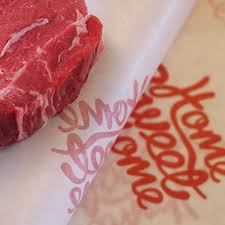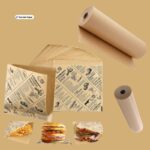What is Butcher Paper?
Butcher paper is a heavy, kraft-style paper that is typically made from wood pulp. Unlike other types of paper, such as deli paper or wax paper, butcher paper is thicker and more durable, which allows it to withstand moisture and grease without tearing easily. It comes in several grades, with pink and white being the most common. The pink variety is sometimes referred to as “peach paper” due to its light pinkish hue, and it is often used in barbecue and smoking, while white butcher paper is more commonly used in butcher shops and delis.
One of the defining characteristics of butcher paper is its breathability. This feature makes it an ideal choice for wrapping meats that need to breathe, allowing moisture and air to circulate while still protecting the food from contaminants. Unlike plastic wrap, which can trap moisture and lead to spoilage, butcher paper keeps the meat fresh while still allowing it to “breathe,” which is critical in maintaining its quality.

Traditional Uses of Butcher Paper
The primary use of butcher paper has always been in butcher shops and grocery stores, where it is used to wrap fresh cuts of meat. When you visit your local butcher and ask for a pound of steak, chances are that the meat will be wrapped in white or pink butcher paper before being handed to you. The paper serves two main functions: it protects the meat from outside contaminants while keeping it fresh, and it prevents juices from leaking through and making a mess.
Butcher paper is also used to package deli items such as sandwiches, cheeses, and cold cuts. In a deli setting, you might find that many sandwiches are wrapped in butcher paper for easy handling and transportation. The strength and durability of the paper make it ideal for wrapping foods that are messy or greasy, such as sandwiches with sauces, greasy meats, or cheese that might leak oils. Deli paper and butcher paper are often used interchangeably in these settings, with both materials serving the same primary purpose of protecting food while keeping it fresh.
Non-Culinary Uses of Butcher Paper
While butcher paper is most commonly associated with food preparation and packaging, it has numerous non-culinary uses as well. In fact, its durability, flexibility, and versatility make it suitable for a wide range of applications outside the kitchen.
Art and Craft Projects
Butcher paper is frequently used in schools, homes, and art studios for various art and craft projects. Its durability makes it ideal for covering large surfaces, such as tables or floors, during messy projects like painting, drawing, or sculpting. Because it’s available in large rolls, butcher paper can be easily cut to size and used as a canvas for large murals, banners, or signs. Children often use butcher paper for drawing or creating art projects, as it is inexpensive and can be used with a variety of materials, including crayons, markers, paint, and glue.
Butcher paper’s strength and texture also make it a popular choice for wrapping presents. The rustic look of brown butcher paper has become increasingly popular for gift wrapping, particularly when paired with twine, ribbon, or other decorative elements. This simple, eco-friendly approach to gift wrapping has gained traction, especially among those who prefer a minimalist aesthetic.
Table Coverings and Event Decorations
Butcher paper is commonly used as a disposable table covering for events, parties, or casual gatherings. Because it’s inexpensive and available in large rolls, it can easily cover long banquet tables or picnic tables, providing a clean, disposable surface for guests to eat on. In restaurants, butcher paper is sometimes used to cover tables, allowing diners to write or draw directly on the paper during the meal. This practice is especially popular in casual seafood restaurants, where diners can crack open shellfish and discard the shells directly onto the butcher paper covering.
In addition to table coverings, butcher paper can also be used to create decorations for events or parties. It can be cut, folded, and shaped into banners, streamers, or other decorative elements, making it a versatile material for DIY event planning.
Environmental Impact of Butcher Paper
One of the key advantages of butcher paper is its relatively low environmental impact compared to other food packaging materials, such as plastic or aluminum foil. Because butcher paper is made from natural wood pulp, it is biodegradable and can be composted after use. Many companies now offer butcher paper that is sourced from sustainable forests or made from recycled materials, further reducing its environmental footprint.
In the USA, sustainability has become an important consideration for both consumers and businesses, leading to an increase in demand for eco-friendly packaging options. Butcher paper is an excellent choice for businesses looking to reduce their reliance on plastic or other non-biodegradable materials. Whether it’s being used in butcher shops, restaurants, or delis, switching to butcher paper can help businesses meet their sustainability goals while still providing high-quality food packaging.
Conclusion
Butcher paper is a versatile, durable, and environmentally friendly material that has a wide range of uses in both the food industry and beyond. Whether it’s being used to wrap fresh cuts of meat in a butcher shop, smoke brisket in the backyard, or create art projects in a classroom, butcher paper has earned its place as an essential tool in many different settings. Its breathability and strength make it ideal for wrapping and preserving food, while its flexibility and durability make it suitable for a variety of non-culinary applications, from packaging to event decorations.
In today’s market, butcher paper is widely available both online and in stores across the USA, making it accessible to home cooks, restaurants, and businesses alike. As consumers and businesses continue to seek out more sustainable options, butcher paper’s eco-friendly qualities are likely to make it an even more popular choice in the years to come. Whether you’re grilling, crafting








